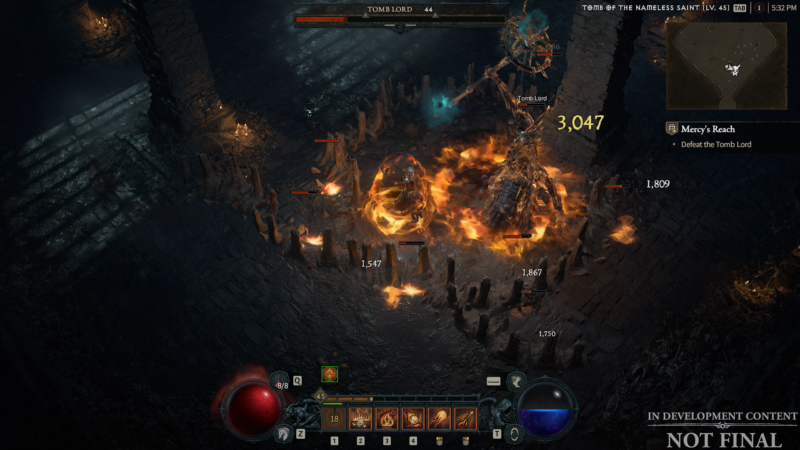
It’s not a stretch to say that the Diablo series is one of the most influential role-playing game franchises of all time. As one of the early action-focused loot games, it offered a deeply compelling and satisfying take on the classic concept of the dungeon crawl. Its many sequels advanced its foundations of rewarding character growth and addictive loot collection. The Diablo games are still well-loved today, but other titles have picked up the baton and taken the genre in new directions.
So with the upcoming Diablo IV, developer Blizzard is seeking to reinvent the classic action RPG, taking the series’ first steps into a dark open world filled to the brim with gruesome violence. While staying true to the game’s isometric action-RPG and dark fantasy roots, Diablo IV brings a more ambitious and freeform adventure, with many new ways to customize your hero as you adventure across the land.
I was able to play over 12 hours of Diablo IV’s opening act in an early beta preview of the game, which showcased its expansive open world and gave a sample of how much power a budding adventurer can attain. It’s already apparent that Diablo IV is less about providing a series of linear dungeon crawls and more about opening the player to a wider world filled with monsters to fight and loot to collect.
Embracing a dark past
Several decades after the defeat of Malthael in Diablo III, things have not improved in the world of Sanctuary. With humanity falling into despair, a desperate group of adventurers seeking loot and power summons the malevolent arch-demon Lilith, who embarks on a brutal campaign to retake the ruined world. With the land poised to plunge even further into darkness, a Barbarian, a Rogue, a Sorceress, a Druid, and a Necromancer take their first steps into Sanctuary. They team up to amass power and infamy, all in pursuit of gaining the strength to defeat Lilith and her army throughout the world of Sanctuary.
According to Diablo IV director Joe Shely, the development team felt it needed a more consistent and striking tone for their trip back to Sanctuary. “[Diablo IV] is much closer to the horror and fantasy roots than recent interactions of the IP,” Shely said during a pre-game presentation. “We want the world of Sanctuary to be scary, challenging, and engaging, but we also want it to be a place worth fighting for. The main theme of the game is ‘hatred.’ Hate will consume Sanctuary and the hearts of our characters, and we will explore its lore and its dire consequences.”
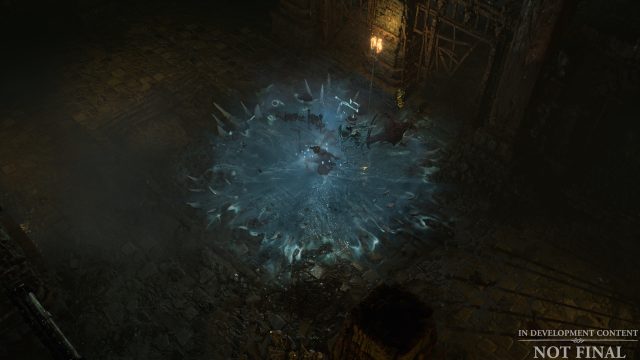
From the game's opening hours, it was clear that Diablo IV is the series' darkest and most violent entry. The bloody opening act—filled with undead monsters, human sacrifices, and lots and lots of blood—effectively sets the mood for this grim adventure. If Diablo III was akin to Peter Jackson's director's cut of the Lord of the Rings trilogy, Diablo IV is much more in the vein of the dark gothic horror of Bram Stoker's Dracula.
This dark atmosphere will be familiar to anyone who remembers the first two Diablo games and their vision of a dark, gothic fantasy world. But Diablo IV’s take on the genre feels more brutal and grotesque. The violence and bleak atmosphere of the game can be a lot to take in at times, but it all connects to the more significant vision of a ruined world.
Opening up
One of the largest departures Diablo IV takes from its predecessors is the shift toward a more open and active world. Previous games tended to focus on fairly linear experiences across different regions with escalating difficulty. Diablo III was the first game to deviate in some ways with its popular adventure mode, which essentially let you ignore the story so you could grind through different areas to level up.
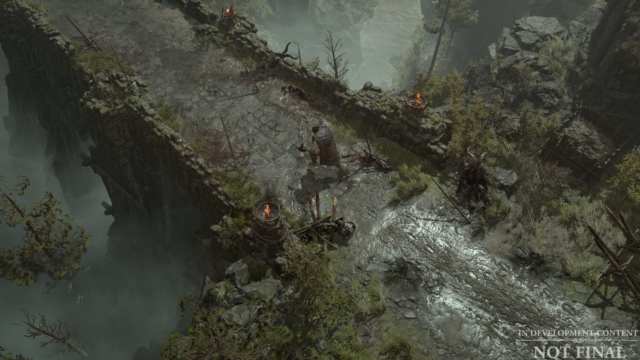
Diablo IV takes some ideas from that adventure mode for its more open-ended approach to the main story. The game starts off relatively linearly, with the main hero making a perilous journey to Sanctuary. Once you get to the game’s first central town, however, you can start to freely explore the different regions of Sanctuary.
"There are so many different ways to approach your progression through the campaign,” Shely said. “You can even cross over into areas from later story acts if you want.”
Shely also emphasized how key aspects of the game design have been integrated into the environmental design. “You're not sitting at a menu tuning your different difficulties or other things to craft your experience, but your options and the activities you can do can be accessed any time by going to locations found on the map,” he said. “It's all to keep you in the game, and you get to see all the activities in the world, other players running around doing quests, and it's just so cool to see that all happen in the world."
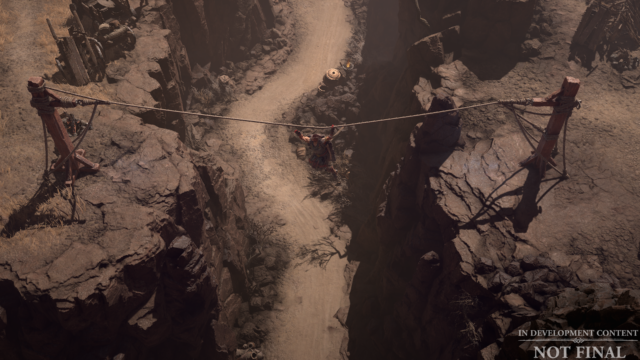
This approach already feels like a distinct step up from the linear nature of Diablo III. While exploring a frozen wasteland called the Fractured Peaks, for instance, I could find world events one moment and stumble upon more standard monster-filled dungeons the next. The revised structure is like a combination of the traditional gameplay loop of Diablo and the zone-based exploration and encounters from Bungie’s Destiny series, a mix that helped the game feel fresh.
Even from this early preview of the game, Diablo IV has an impressively designed map, and I felt constantly rewarded for choosing to stray from the main quest. It felt genuinely exciting to explore the map freely as opposed to being funneled down certain paths. I also appreciated how most areas of the map are fleshed out with activity, with less of the “big open area with a lot of enemies” problem seen in previous Diablo games.
More flexible customization
Diablo IV’s adventurers bring back the familiar band of role-playing archetypes that fans expect. However, there’s a greater emphasis on customization than in previous entries, introducing some interesting twists on how each class evolves throughout the journey.
You’ll still be able to live those familiar fantasies of dishing out ranged magic damage or barreling through hordes of foes with a massive hammer, depending on your chosen class. Now, though, there are class-specific “X-factors” that affect how your character plays.

The Barbarian class, for instance, can now carry up to four different weapons—two one-handed weapons and two two-handed weapons—at the same time. Depending on how you outfit the character, you can swap between weapons and their associated skills in the middle of combat. This makes the Barbarian feel like a powerful mobile arsenal of weapons and allows for many more tactical crowd-control options.
Changes like these aren’t quite a ground-up rethinking of the classic Diablo classes, but they lead to some interesting twists on how classes are designed this time around.
Diablo IV also brings back the familiar skill point system, allowing you to create more in-depth builds and specializations for your class as you level up. You can freely unlock new moves and spend skill points on buffs to outfit your chosen hero as you see fit. It plays out like something of a blend between Diablo III’s skill loadouts and Diablo II’s skill tree, though you don't spend points on character attributes. There are also more options than ever in building the look of your character, complementing the larger focus on player choice this time around.
Initially, the degree of freedom in customization was somewhat overwhelming. The skill tree for each class is sprawling, encompassing passive buffs and active combat maneuvers. The skill tree also doesn't require a linear path to unlock skills. Instead, just investing points in key areas will unlock access to the deeper parts of the tree, allowing you to move around the class tree more freely to focus on skills and buffs that you want for your character. The system took some time to get used to, but I soon began to appreciate how it allows for more flexible character growth.
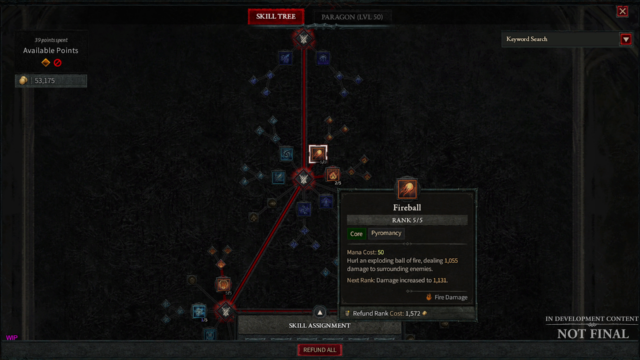
Diablo franchise General Manager Rod Fergusson talked about the game’s renown system, which gives completionists like him some extra guidance. “It rewards you for accomplishing certain goals for your character,” he said, “and extends to other characters you make on your account by giving them bonus skill points to spend at the beginning.”
“Creating new characters and having them potentially start with 12 skill points is fundamentally a different experience and really interesting,” Ferguson continued. “So we really wanted to have players have a greater idea of their journey in the game’s open world, and we believe the renown system will be very beneficial for them.”
A “live” future?
The developers also stressed how Diablo IV's embrace of the “live service” model and its focus on post-launch content creates more incentives for players to explore the other classes beyond their favorite ones. In light of the issues Blizzard’s Overwatch 2 has faced since launch, however, I have concerns about Diablo IV’s vision for a battle pass and other post-launch content. Unfortunately, the Blizzard devs wouldn't expand much on this point, but hopefully lessons learned from Overwatch 2’s rough launch will ensure that Diablo IV gets off to a better start when it launches.I came away from this preview impressed and optimistic about Diablo IV’s vision for a more open-ended and darker fantasy RPG world. The moment-to-moment hack-and-slack gameplay that put Diablo on the map is still strong here, and the new map structure and character class tweaks keep things feeling fresh. While we’ll have to see how the “live service” design of the game plays out, Diablo IV’s more open world is already off to a solid start, and I can’t wait to see more of what the game will offer.
https://ift.tt/7wVqMiZ
Technology
No comments:
Post a Comment